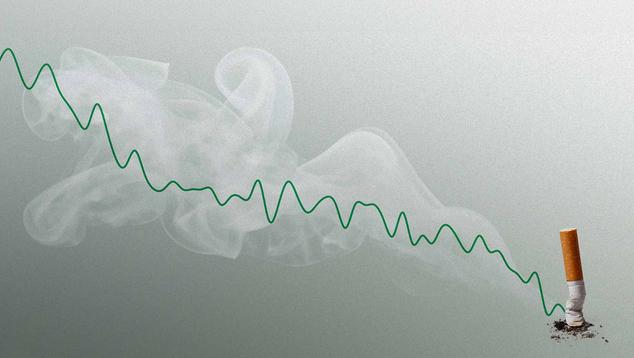Story Highlights
- Rate declines to 11% as fewer young adults smoke cigarettes
- Seven percent of U.S. adults use e-cigarettes
- Majorities view cigarettes, e-cigarettes as very harmful
WASHINGTON, D.C. -- Cigarette smoking in the U.S. is at a low point, according to eight decades of Gallup trends. Currently, 11% of U.S. adults say they have smoked cigarettes in the past week, matching the historical low measured in 2022 (and nearly matched at 12% in 2023). When Gallup first asked about cigarette smoking in 1944, 41% of U.S. adults said they smoked. The current smoking rate is about half as large as it was a decade ago and one-third as large as it was in the late 1980s.
The latest results are based on Gallup’s annual Consumption Habits poll, conducted July 1-21. Between the initial measurement of smoking in 1944 and 1974, at least four in 10 adults said they smoked cigarettes. Now, barely one in 10 do.
A major reason for the decline is that cigarette smoking has plummeted among young adults, who typically had been the most likely age group to smoke. Over the past three years, an average of 6% of adults under age 30 say they have smoked cigarettes in the past week, compared with 35% of young adults in 2001 through 2003 surveys.
Young adults are now less likely than other age groups to smoke cigarettes, as 13% of those between the ages of 30 and 49, 18% of those aged 50 to 64 and 9% of those 65 and older say they smoke.
Smoking continues to show a relationship to educational attainment, as 5% of college graduates and 15% of those without a college degree say they have smoked cigarettes, based on combined 2022-2024 data. The rates for both groups are significantly lower than in the past -- between 2001 and 2003, an average of 14% of college graduates and 30% of college nongraduates reported smoking.
Younger Adults More Likely to Smoke E-Cigarettes
Vaping is less common than cigarette smoking, with 7% of U.S. adults saying they have smoked electronic cigarettes or “vaped” in the past week. The percentage of vapers has been steady between 6% and 8% of U.S. adults in Gallup polls since 2019.
While young adults are now the age group least likely to smoke cigarettes, they are the group most likely to smoke e-cigarettes, according to combined 2022-2024 data. Eighteen percent of adults aged 18 to 29 vape, with the percentage declining among older age groups, down to 1% of those 65 and older.
There are small educational differences in vaping, with 5% of college graduates versus 9% of college nongraduates using e-cigarettes.
Most Americans View Cigarettes, E-Cigarettes as Very Harmful
The generally low rates of cigarette and e-cigarette usage may stem from the perception that these products can cause harm. Seventy-nine percent of U.S. adults say cigarettes are “very harmful” to people who use them; 57% say the same about e-cigarettes.
A majority of U.S. adults also consider chewing tobacco to be “very harmful” to its users, though fewer say this about cigars, pipes or nicotine pouches. Still, majorities of at least seven in 10 Americans believe all of these substances are at least “somewhat harmful.”
Americans who smoke are less inclined than nonsmokers to consider the substance they use as harmful. While 58% of cigarette smokers think cigarettes are very harmful, 80% of those who do not smoke cigarettes hold this view. And 63% of vapers think e-cigarettes are very harmful, compared with 79% of nonvapers.
There are not notable differences in perceived harm of cigarettes or e-cigarettes by age or educational attainment.
Bottom Line
Medical experts have long warned of the health dangers of smoking, and those educational efforts may be a factor in explaining why cigarette smoking is at an 80-year low. The most recent cohort of young adults are responsible for much of the change. They have bucked the historical trends whereby young adults have been most likely to smoke cigarettes.
However, today’s young adults may have substituted e-cigarettes for tobacco cigarettes, as roughly three times as many young adults vape as smoke cigarettes. Still, vaping rates among this group are lower than cigarette-smoking rates of young adults in the past.
Fewer U.S. adults vape than smoke cigarettes today, but if current age trends persist -- meaning today’s young adults continue to vape as they reach middle age, and today’s children vape at high rates when they reach adulthood -- vaping may soon surpass cigarette smoking as the more common activity. While vaping presents fewer health risks than tobacco smoking, public health officials would still prefer that U.S. adults not do either.
To stay up to date with the latest Gallup News insights and updates, follow us on X @Gallup.
Learn more about how the Gallup Poll Social Series works.
View complete question responses and trends (PDF download).




